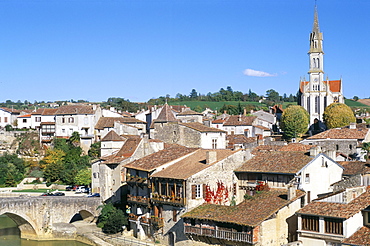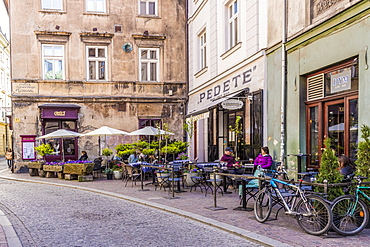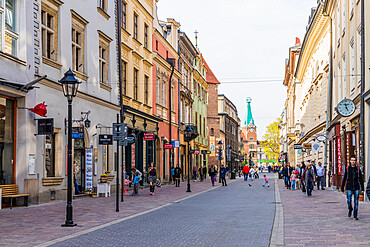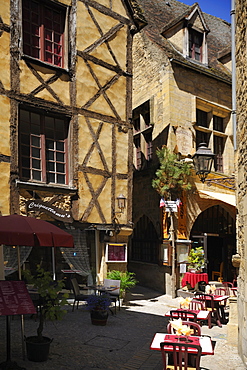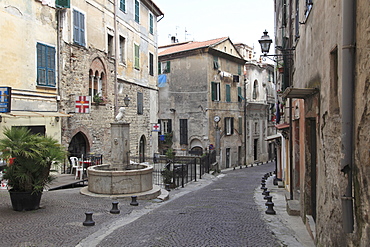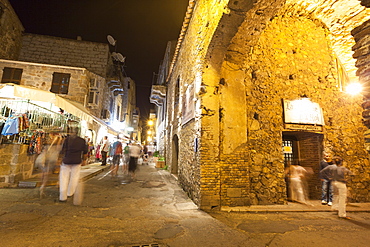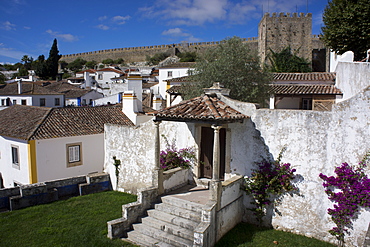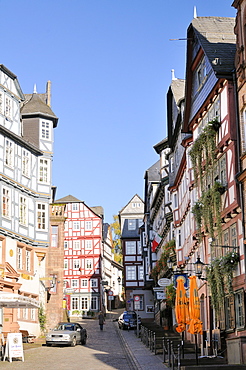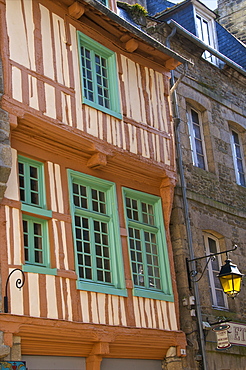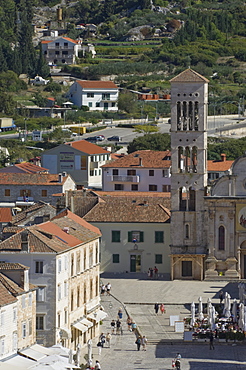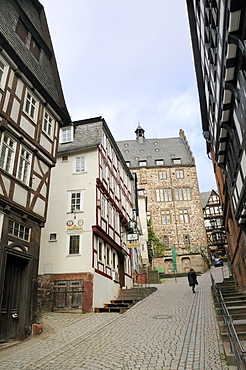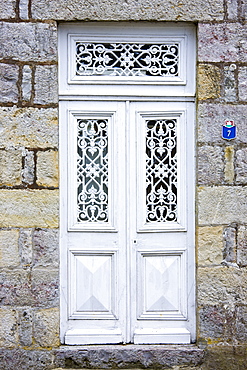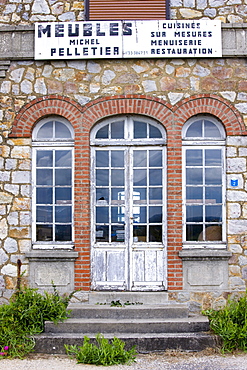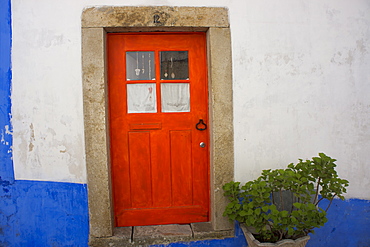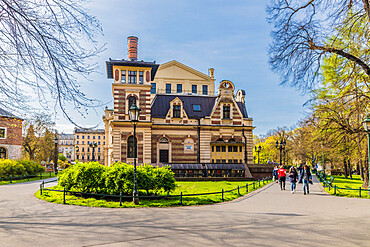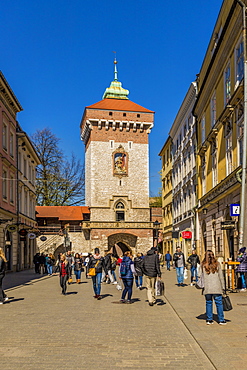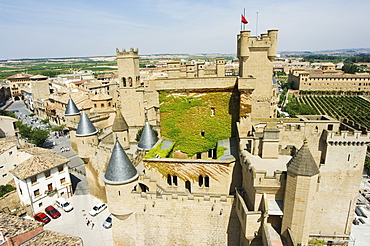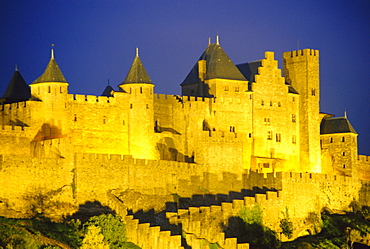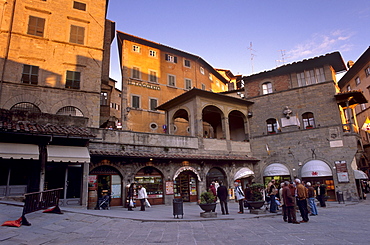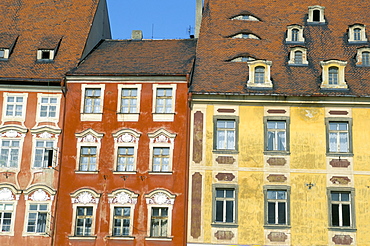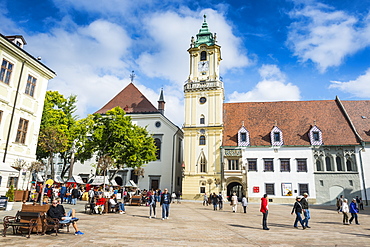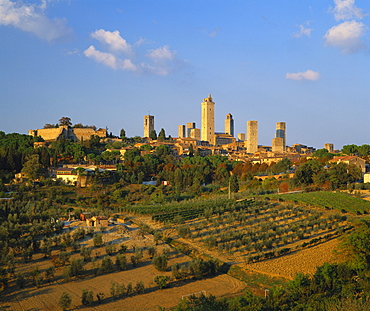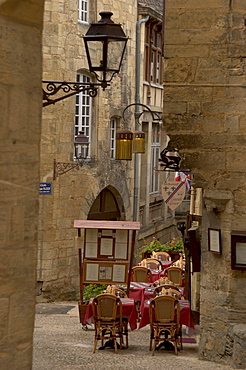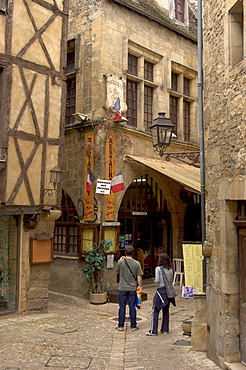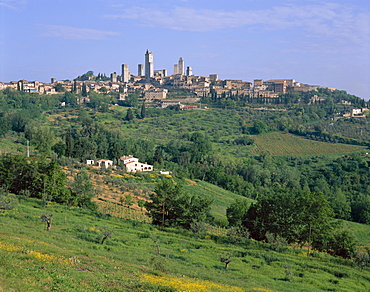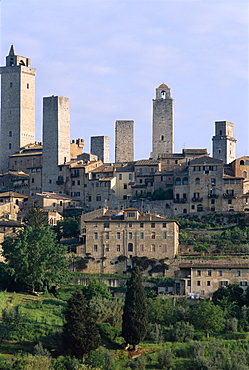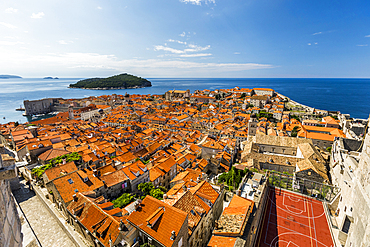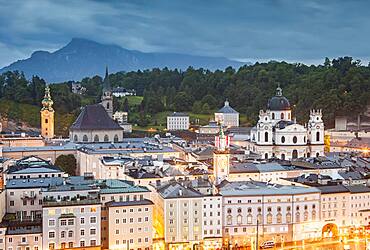Results
« Previous 1 … 10 11 12
1121 results found

Medieval street in walled and turreted fortress of La Cite, Carcassonne, UNESCO World Heritge Site, Languedoc, France, Europe
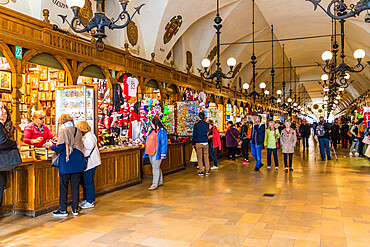
The market hall in Cloth Hall in the medieval old town, a UNESCO World Heritage Site, Krakow, Poland, Europe
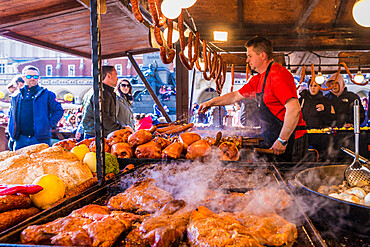
A market stall in the main square, Rynek Glowny, in the medieval old town, UNESCO World Heritage Site, Krakow, Poland, Europe
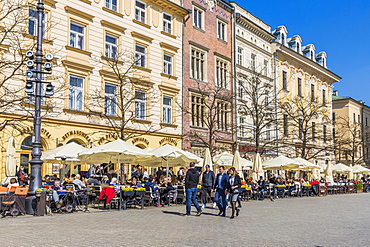
A cafe scene in the main square, Rynek Glowny, in the medieval old town, UNESCO World Heritage Site, Krakow, Poland, Europe

Cloth Hall in the main square, Rynek Glowny, in the medieval old town, UNESCO World Heritage Site, Krakow, Poland, Europe
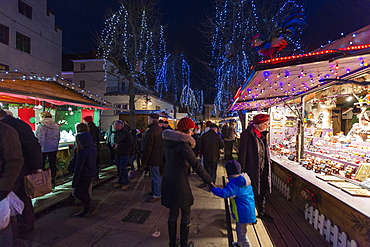
Tourists and Christmas Markets in the old medieval town of Riquewihr, Haut-Rhin department, Alsace, France, Europe
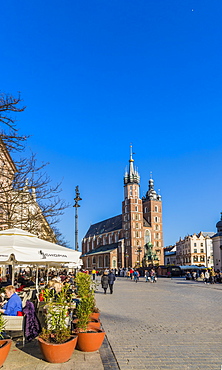
St. Mary's Basilica in the main square in the medieval old town of Krakow, UNESCO World Heritage Site, Krakow, Poland, Europe

Close-up of dormer windows in the roof of a building in the market square of the medieval town of Cheb in Bohemia, Czech Republic, Europe
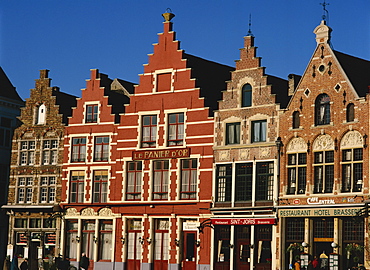
Gabled buildings around the Markt, or Market Square, in the medieval town of Bruges, Belgium, Europe
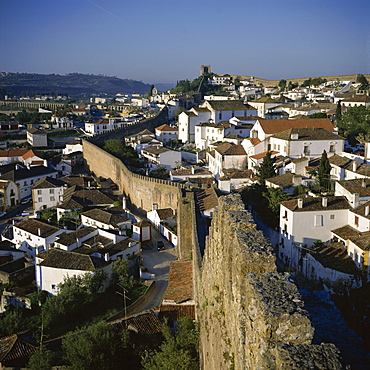
Walled medieval town, traditional wedding gift of kings to queens, Obidos, Estremadura, Portugal, Europe
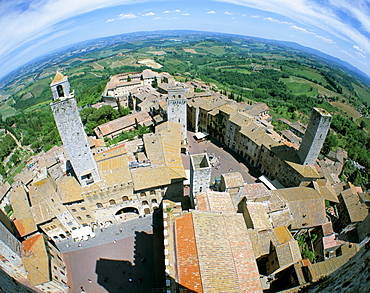
Looking down on San Gimignano from one of the town's medieval stone towers, San Gimignano, UNESCO World Heritage Site, Tuscany, Italy, Europe
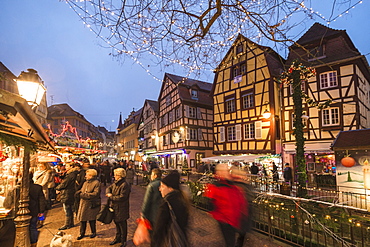
Tourists shopping at the Christmas Markets in the old medieval town of Colmar, Haut-Rhin department, Alsace, France, Europe
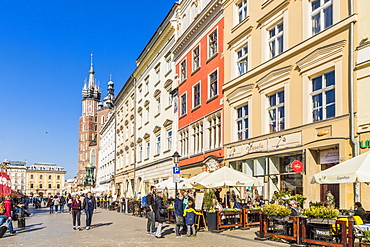
The main square, Rynek Glowny, in the medieval old town, UNESCO World Heritage Site, Krakow, Poland, Europe

A tram outside the Dominican church in the medieval old town, UNESCO World Heritage Site, in Krakow, Poland, Europe
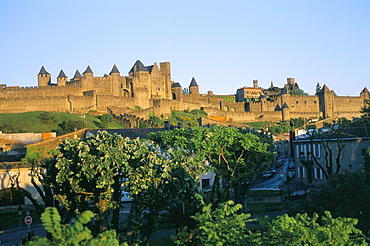
The medieval city of Carcassonne, UNESCO World Heritage Site, Aude, Languedoc Roussillon, France, Europe
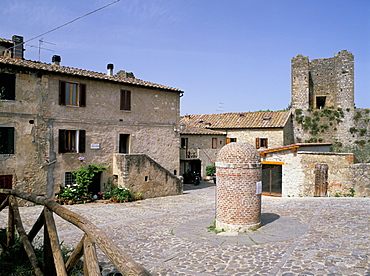
Cobbled square, the Largo di Fontebranda, with old houses and tower in best preserved medieval village in Tuscany, Monteriggioni, Siena, Tuscany, Italy, Europe
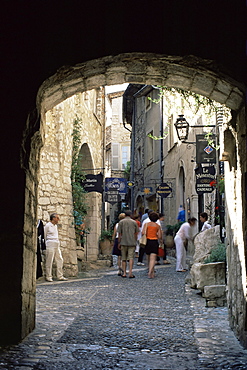
View through archway of narrow medieval alley, St. Paul de Vence, Alpes-Maritimes, Provence, France, Europe
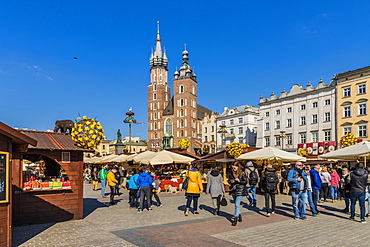
St. Mary's Basilica in the main square in the medieval old town of Krakow, UNESCO World Heritage site, in Krakow, Poland, Europe
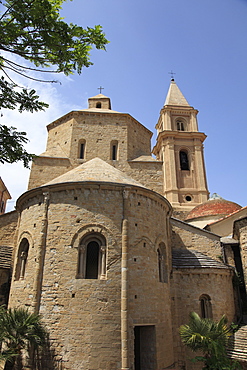
Cathedral, Santa Maria Assunta, Old Town, Ventimiglia, Medieval, Liguria, Imperia Province, Italy, Europe
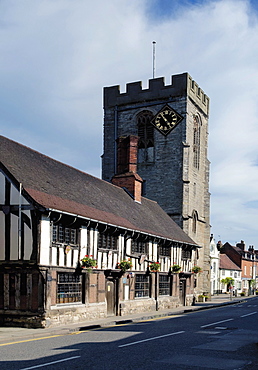
Medieval Tudor Guildhall and church of St. John the Baptist, High Street, Henley in Arden, Warwickshire, England, United Kingdom, Europe

Medieval half timbered houses, with viaduct in the background, old town, Morlaix, Finistere, Brittany, France, Europe
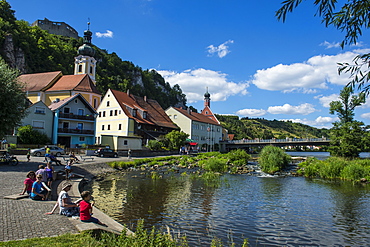
Kallmuenz Castle above medieval houses in the center of Kallmuenz on the Naab, Bavaria, Germany, Europe
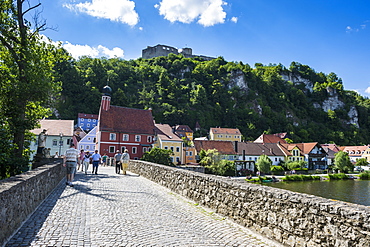
Kallmuenz Castle above medieval houses in the center of Kallmuenz on the Naab, Bavaria, Germany, Europe
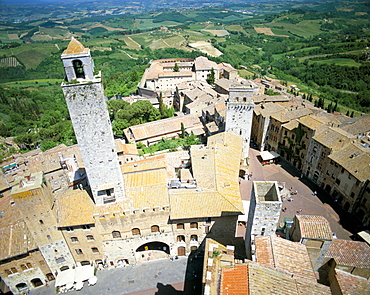
Looking down on San Gimignano from one of the town's medieval stone towers, San Gimignano, UNESCO World Heritage Site, Tuscany, Italy, Europe
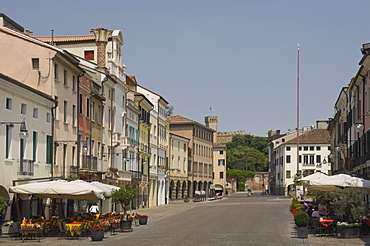
Street cafes in the main street of the medieval town of Este, Province of Padua, Veneto, Italy, Europe
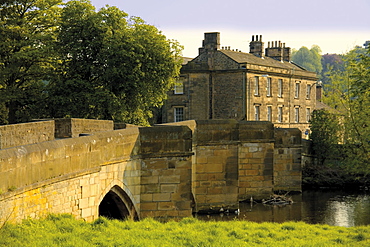
Medieval bridge over the River Wye, Bakewell, Derbyshire, Peak District National Park, England, United Kingdom, Europe
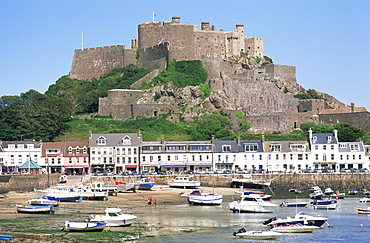
Mont Orgueil Castle, 13th century Medieval castle, Gorey, Jersey, Channel Islands, United Kingdom, Europe
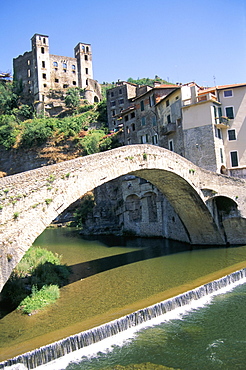
Medieval bridge across the River Nervia and 15th century Doria's castle, Dolceacqua, Italian Riviera, Liguria, Italy, Mediterranean, Europe
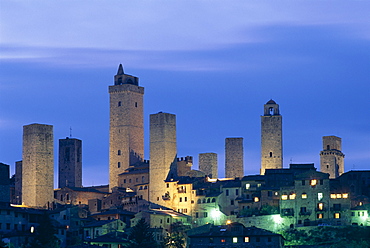
Medieval towers at night, San Gimignano, UNESCO World Heritage Site, Tuscany (Toscana), Italy, Europe
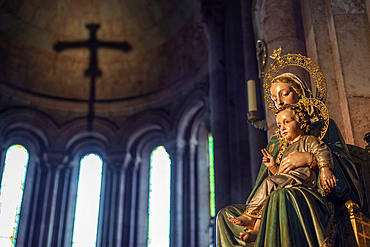
Inside Basílica de Santa María la Real de Covadonga catholic church in Cangas de Onis, Picos de Europa, Asturias, Spain, Europe.
In 1777 a fire destroyed the old temple, which stood adjacent to the Holy Cave where Our Lady of Covadonga is revered. It was then decided to raise a new church as a monumental sanctuary, raising donations from all of Spain; the plan was opposed by the local council, as the canons wanted to rebuild the temple of the Holy Cave and build an ambitious sanctuary that had once been designed by Ventura Rodríguez, but never completed. One century later, the project was resumed by King Alfonso XII of Spain, who was interested in completing this work. The classic design of Ventura Rodríguez was very difficult and expensive and was replaced by a new neo-Medieval design.
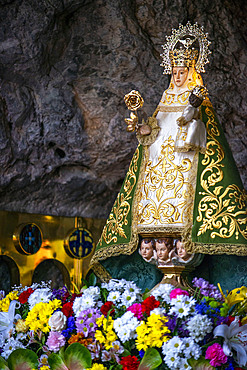
Our Lady of Covadonga. The Blessed Virgin Mary, and a Marian shrine devoted to her at Basílica de Santa María la Real de Covadonga catholic church in Cangas de Onis, Picos de Europa, Asturias, Spain, Europe.
In 1777 a fire destroyed the old temple, which stood adjacent to the Holy Cave where Our Lady of Covadonga is revered. It was then decided to raise a new church as a monumental sanctuary, raising donations from all of Spain; the plan was opposed by the local council, as the canons wanted to rebuild the temple of the Holy Cave and build an ambitious sanctuary that had once been designed by Ventura Rodríguez, but never completed. One century later, the project was resumed by King Alfonso XII of Spain, who was interested in completing this work. The classic design of Ventura Rodríguez was very difficult and expensive and was replaced by a new neo-Medieval design.
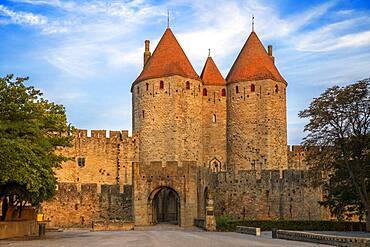
Fortified City of Carcassonne, medieval city listed as World Heritage by UNESCO, harboure d'Aude, Languedoc-Roussillon Midi Pyrenees Aude France
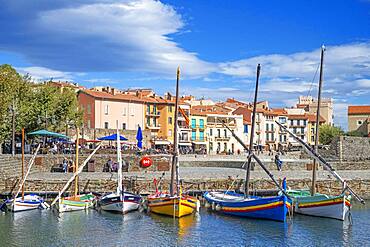
Typical boats and Notre-Dame-des-Anges church and landscape seaside beach of the picturesque village of Collioure, near Perpignan at south of France Languedoc-Roussillon Cote Vermeille Midi Pyrenees Occitanie Europe
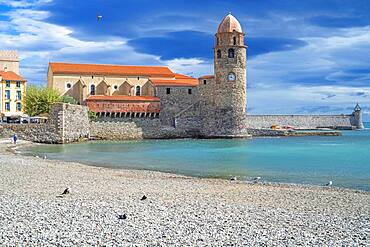
Notre-Dame-des-Anges church and landscape seaside beach of the picturesque village of Collioure, near Perpignan at south of France Languedoc-Roussillon Cote Vermeille Midi Pyrenees Occitanie Europe
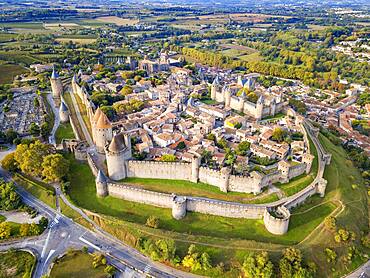
Aerial view of Carcassonne, medieval city listed as World Heritage by UNESCO, harboure d'Aude, Languedoc-Roussillon Midi Pyrenees Aude France
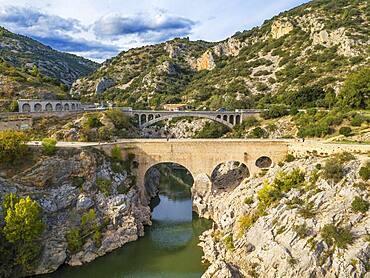
Pont du Diable, the Devil's Bridge, over Hérault River, near Saint Guilhem le Désert, Hérault, Languedoc Roussillon. Saint Jean de Fos, the Pont du Diable over the Herault river on the Routes of Santiago de Compostela, listed as World Heritage by UNESCO, Herault, France.
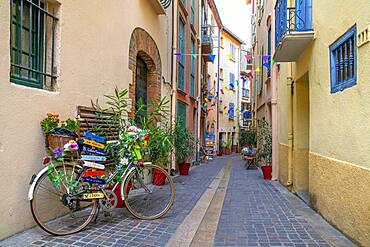
Street in the medieval town of Collioure in the south of France Languedoc-Roussillon Cote Vermeille Midi Pyrenees Occitanie Europe
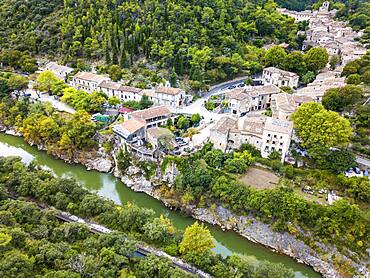
Aerial view Saint Guilhem le Desert, labelled Les Plus Beaux Villages de France (The Most Beautiful Villages of France), a stop on el Camino de Santiago, Herault, France.
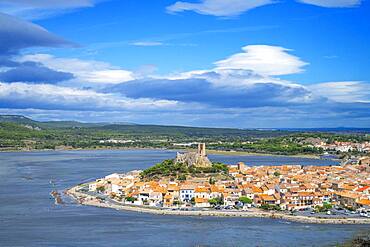
View of the watchtower at Gruissan in Languedoc-Roussillon, France, Aude, Gruissan, village in Circulade testifies of a Medieval origin, strategic sign of defense and Christian symbol
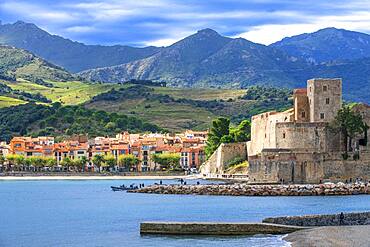
Royal castle of Collioure and landscape seaside beach of the picturesque village of Colliure, near Perpignan at south of France Languedoc-Roussillon Cote Vermeille Midi Pyrenees Occitanie Europe
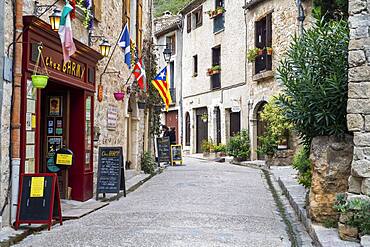
Saint Guilhem le Desert, labelled Les Plus Beaux Villages de France (The Most Beautiful Villages of France), a stop on el Camino de Santiago, Herault, France. Street scene of St Guilhem le Desert, pedestrian road with old historical houses on both side. St-Guilhem, France.

Bars and restaurants in the main street in the medieval town of Collioure in the south of France Languedoc-Roussillon Cote Vermeille Midi Pyrenees Occitanie Europe
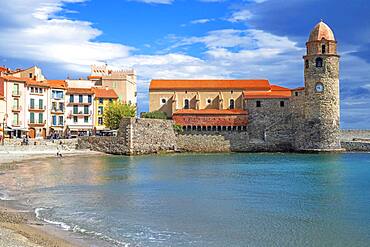
Notre-Dame-des-Anges church and landscape seaside beach of the picturesque village of Collioure, near Perpignan at south of France Languedoc-Roussillon Cote Vermeille Midi Pyrenees Occitanie Europe
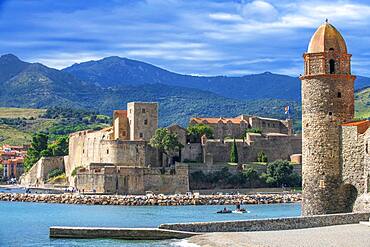
Royal castle of Collioure and landscape seaside beach of the picturesque village of Colliure, near Perpignan at south of France Languedoc-Roussillon Cote Vermeille Midi Pyrenees Occitanie Europe
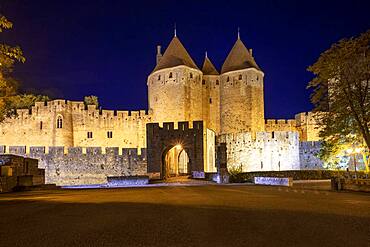
Fortified City of Carcassonne, medieval city listed as World Heritage by UNESCO, harboure d'Aude, Languedoc-Roussillon Midi Pyrenees Aude France
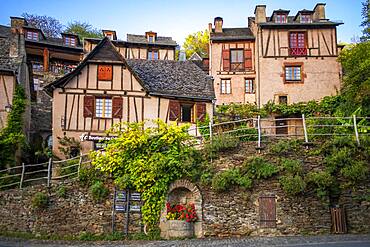
The small medieval village of Conques in France. It shows visitors its abbey-church and clustered houses topped by slate roofs. Crossing of narrow streets and monolith to the fallen ones in the war in the old medieval village of Conques on coats of the river Dordou
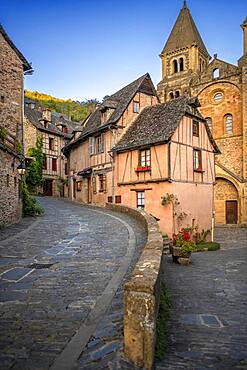
The small medieval village of Conques in France. It shows visitors its abbey-church and clustered houses topped by slate roofs. Crossing of narrow streets and monolith to the fallen ones in the war in the old medieval village of Conques on coats of the river Dordou
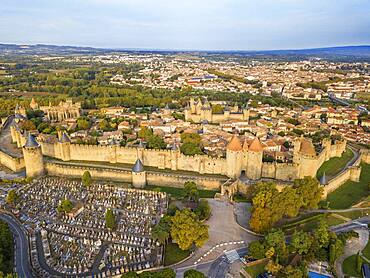
Aerial view of Carcassonne, medieval city listed as World Heritage by UNESCO, harboure d'Aude, Languedoc-Roussillon Midi Pyrenees Aude France
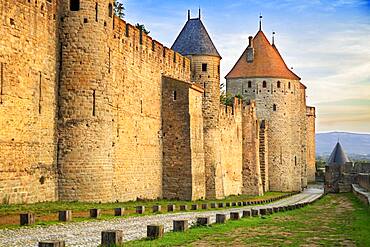
Fortified City of Carcassonne, medieval city listed as World Heritage by UNESCO, harboure d'Aude, Languedoc-Roussillon Midi Pyrenees Aude France
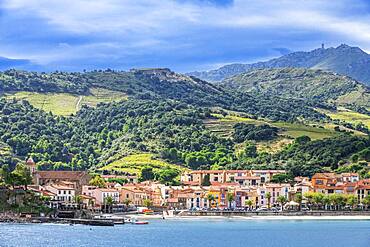
Landscape seaside beach of the picturesque village of Collioure, near Perpignan at south of France Languedoc-Roussillon Cote Vermeille Midi Pyrenees Occitanie Europe
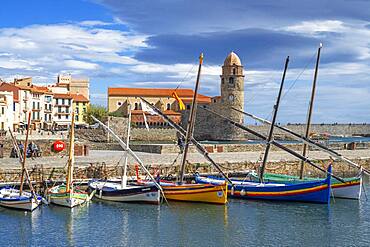
Typical boats and Notre-Dame-des-Anges church and landscape seaside beach of the picturesque village of Collioure, near Perpignan at south of France Languedoc-Roussillon Cote Vermeille Midi Pyrenees Occitanie Europe
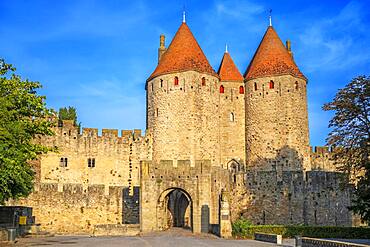
Fortified City of Carcassonne, medieval city listed as World Heritage by UNESCO, harboure d'Aude, Languedoc-Roussillon Midi Pyrenees Aude France
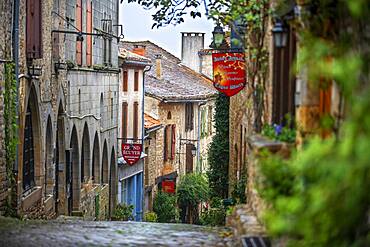
Medieval town of Cordes sur Ciel, labelled The Most Beautiful Villages of France, Tarn, Occitanie, France
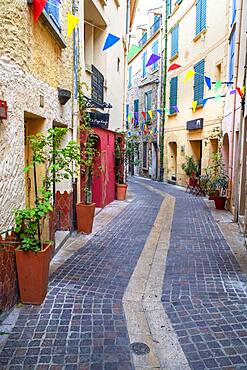
Street in the medieval town of Collioure in the south of France Languedoc-Roussillon Cote Vermeille Midi Pyrenees Occitanie Europe
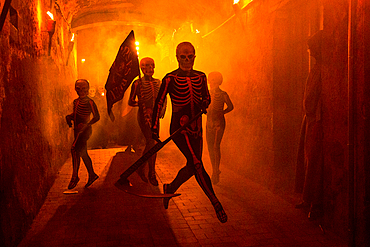
Verges, a small town in the Northeast of Catalonia (Spain), during Easter celebrates the Procession of Verges with skeletons dancing on the sound of a drum, Roman soldiers, known as the 'Manages', and a representation of the life and crucifixion of Jesus Christ. The Procession features the Dance of Death, a tradition from the Middle Age associated with epidemics and plagues and the only one remaining in Spain Ten skeletons dance to the beat of a drum to remember that no one is exempt of death. The backdrop of the medieval walls and towers of Verges is key to this macabre staging.
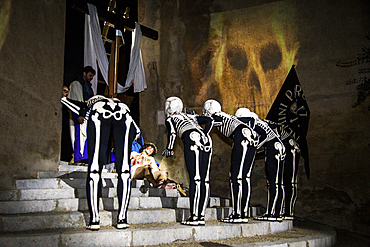
Verges, a small town in the Northeast of Catalonia (Spain), during Easter celebrates the Procession of Verges with skeletons dancing on the sound of a drum, Roman soldiers, known as the 'Manages', and a representation of the life and crucifixion of Jesus Christ. The Procession features the Dance of Death, a tradition from the Middle Age associated with epidemics and plagues and the only one remaining in Spain Ten skeletons dance to the beat of a drum to remember that no one is exempt of death. The backdrop of the medieval walls and towers of Verges is key to this macabre staging.
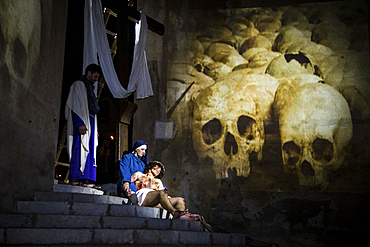
Verges, a small town in the Northeast of Catalonia (Spain), during Easter celebrates the Procession of Verges with skeletons dancing on the sound of a drum, Roman soldiers, known as the 'Manages', and a representation of the life and crucifixion of Jesus Christ. The Procession features the Dance of Death, a tradition from the Middle Age associated with epidemics and plagues and the only one remaining in Spain Ten skeletons dance to the beat of a drum to remember that no one is exempt of death. The backdrop of the medieval walls and towers of Verges is key to this macabre staging.
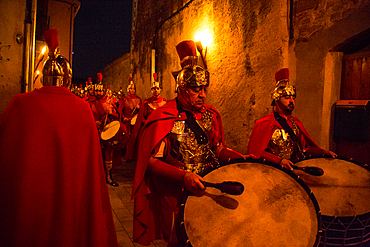
Verges, a small town in the Northeast of Catalonia (Spain), during Easter celebrates the Procession of Verges with skeletons dancing on the sound of a drum, Roman soldiers, known as the 'Manages', and a representation of the life and crucifixion of Jesus Christ. The Procession features the Dance of Death, a tradition from the Middle Age associated with epidemics and plagues and the only one remaining in Spain Ten skeletons dance to the beat of a drum to remember that no one is exempt of death. The backdrop of the medieval walls and towers of Verges is key to this macabre staging.
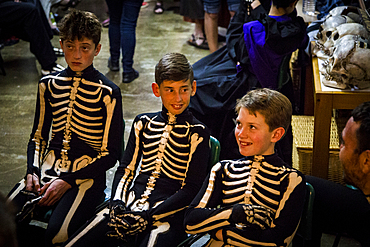
Verges, a small town in the Northeast of Catalonia (Spain), during Easter celebrates the Procession of Verges with skeletons dancing on the sound of a drum, Roman soldiers, known as the 'Manages', and a representation of the life and crucifixion of Jesus Christ. The Procession features the Dance of Death, a tradition from the Middle Age associated with epidemics and plagues and the only one remaining in Spain Ten skeletons dance to the beat of a drum to remember that no one is exempt of death. The backdrop of the medieval walls and towers of Verges is key to this macabre staging.
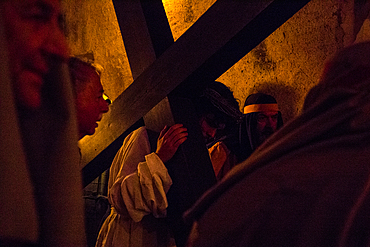
Verges, a small town in the Northeast of Catalonia (Spain), during Easter celebrates the Procession of Verges with skeletons dancing on the sound of a drum, Roman soldiers, known as the 'Manages', and a representation of the life and crucifixion of Jesus Christ. The Procession features the Dance of Death, a tradition from the Middle Age associated with epidemics and plagues and the only one remaining in Spain Ten skeletons dance to the beat of a drum to remember that no one is exempt of death. The backdrop of the medieval walls and towers of Verges is key to this macabre staging.
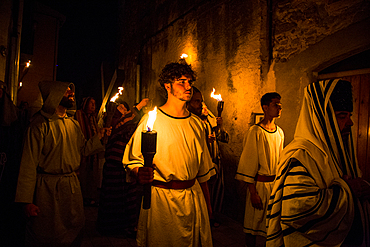
Verges, a small town in the Northeast of Catalonia (Spain), during Easter celebrates the Procession of Verges with skeletons dancing on the sound of a drum, Roman soldiers, known as the 'Manages', and a representation of the life and crucifixion of Jesus Christ. The Procession features the Dance of Death, a tradition from the Middle Age associated with epidemics and plagues and the only one remaining in Spain Ten skeletons dance to the beat of a drum to remember that no one is exempt of death. The backdrop of the medieval walls and towers of Verges is key to this macabre staging.
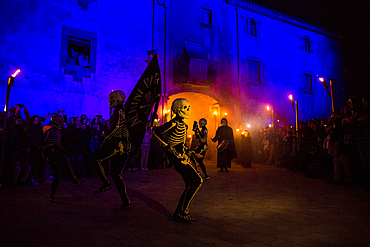
Verges, a small town in the Northeast of Catalonia (Spain), during Easter celebrates the Procession of Verges with skeletons dancing on the sound of a drum, Roman soldiers, known as the 'Manages', and a representation of the life and crucifixion of Jesus Christ. The Procession features the Dance of Death, a tradition from the Middle Age associated with epidemics and plagues and the only one remaining in Spain Ten skeletons dance to the beat of a drum to remember that no one is exempt of death. The backdrop of the medieval walls and towers of Verges is key to this macabre staging.
